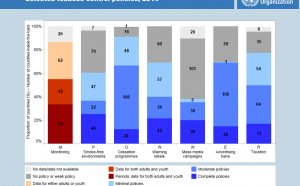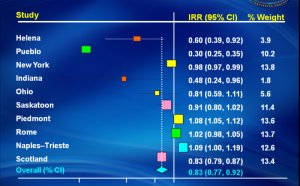
Tobacco social effects
- Centre for Reviews and Dissemination, University of York, York YO10 5DD, UK
- PEHRU, London School of Hygiene and Tropical Medicine, London WC1E 7HT, UK
- Division of Public Health, University of Liverpool L69 3GB, UK
- MRC Epidemiology Unit, Cambridge CB2 0QQ, UK
- Sian Thomas, c/o MRC Social and Public Health Sciences Unit, Glasgow G12 8RZ, UK; sian.thomas{at}btinternet.com
- Received 20 October 2007
Abstract
Objective: To assess the effects of population tobacco control interventions on social inequalities in smoking.
Data sources: Medical, nursing, psychological, social science and grey literature databases, bibliographies, hand-searches and contact with authors.
Study selection: Studies were included (n = 84) if they reported the effects of any population-level tobacco control intervention on smoking behaviour or attitudes in individuals or groups with different demographic or socioeconomic characteristics.
Data extraction: Data extraction and quality assessment for each study were conducted by one reviewer and checked by a second.
Data synthesis: Data were synthesised using graphical (“harvest plot”) and narrative methods. No strong evidence of differential effects was found for smoking restrictions in workplaces and public places, although those in higher occupational groups may be more likely to change their attitudes or behaviour. Smoking restrictions in schools may be more effective in girls. Restrictions on sales to minors may be more effective in girls and younger children. Increasing the price of tobacco products may be more effective in reducing smoking among lower-income adults and those in manual occupations, although there was also some evidence to suggest that adults with higher levels of education may be more price-sensitive. Young people aged under 25 are also affected by price increases, with some evidence that boys and non-white young people may be more sensitive to price.
Conclusions: Population-level tobacco control interventions have the potential to benefit more disadvantaged groups and thereby contribute to reducing health inequalities.
Footnotes
- Funding: This review was funded by the Department of Health Policy Research Programme (PRP) (reference number RDD/030/077). This work was undertaken by all the authors, who received funding from Department of Health Policy Research Programme. The views expressed in the publication are those of the authors and not necessarily those of the Department of Health. MP was funded by the Chief Scientist Office of the Scottish Executive Health Department. DO was funded by a Medical Research Council fellowship. The authors’ work was independent of the funders.
- Competing interests: None.
- Contributors: DO, AJS, MP and MW designed the study. DO designed and populated the harvest plot. KM conducted the literature searches. ST, DF and GW screened the search results, assessed studies for inclusion, conducted data extraction and quality assessment and synthesised the data. ST, DF, GW, MP and AJS checked data extraction and quality assessment. All authors contributed to the interpretation of findings for research and policy. ST wrote the first draft of the manuscript and all other authors contributed to its critical revision and approved the final version. ST is guarantor.
Share this Post
Related posts
Non smoking States
Most states have some laws that protect smokers from discrimination. However, due to the health hazards related to smoking…
Read MoreSmoking ban in public places
Secondhand smoke is a mixture of gases, fine particles and toxic chemicals exhaled from a person who is smoking a burning…
Read More










